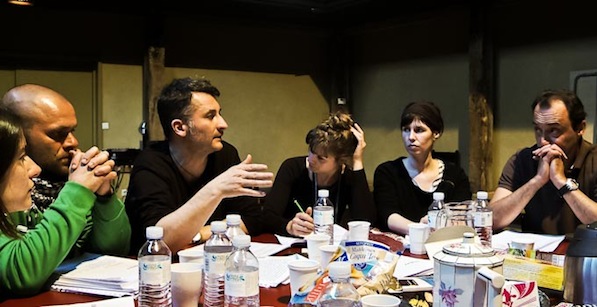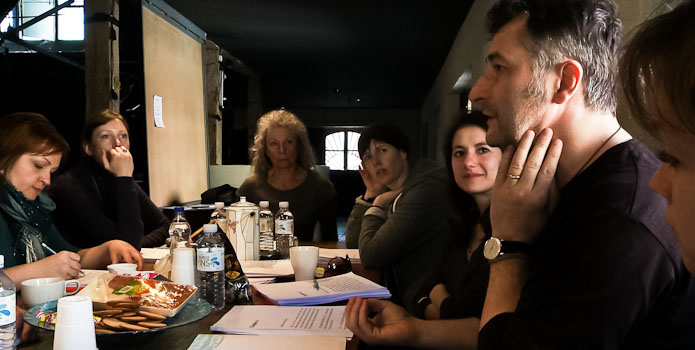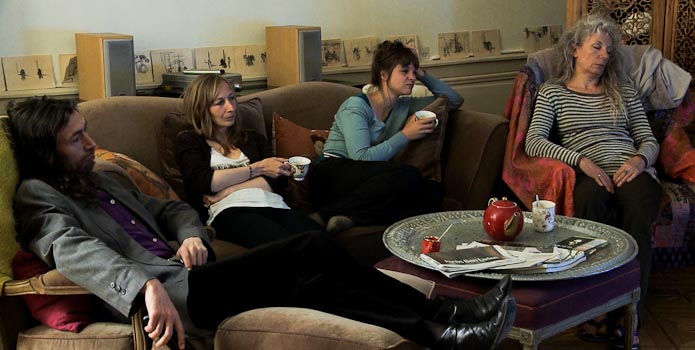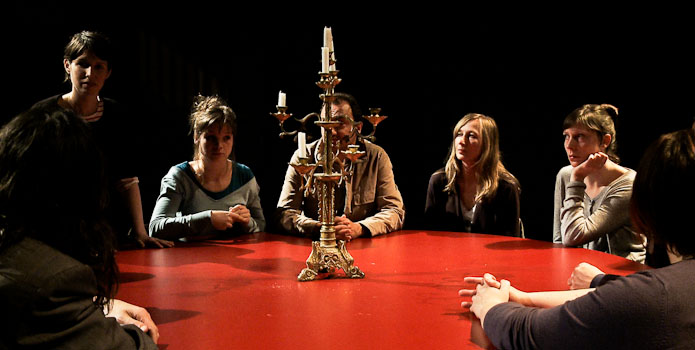As you may have gathered from the title, I want to consider the latest project from Romanian director Cristi Puiu, which screened in the Wavelengths section of this year’s Toronto International Film Festival, in light of a very different project that was also featured at TIFF. This project (in no way, shape or form a “film”), making its second annual appearance at the festival, is the Jason Reitman “table read,” a major-league hipster event in which the director of Juno (and the son of one of TIFF’s biggest financial benefactors) gathers a bunch of his famous friends in an auditorium to deliver an impromptu verbal delivery of some “contemporary classic” screenplay. In 2012, it was American Beauty; this year it was 5. The less said about these events the better—a simple Google search will tell you everything you want to know—but the important thing is this: despite Reitman’s draping these events with all the trappings of actorly woodshedding (bare stage, no costumes, long seminar table, rehearsal-as-performance), there is never any sense that anything remotely risky could happen in these events. Reitman selects known properties for the reads, guaranteed to entertain through back-of-the-hand familiarity. What’s more, he chooses his participants for their star wattage, so that their very presence in the room (sitting at a table!) obviates any need for artistic exploration. In short, Reitman is selling slick professionalism in homemade jam jars, Hollywood product repurposed as black-box theater.
By contrast, Three Interpretation Exercises is most certainly a film. It’s a film that seems to have emerged after the fact, however, as an organic outgrowth of a three-week workshop that Puiu conducted with members of the Chantiers Nomades actors’ studio, along with cinematographer Luchian Ciobanu, with whom Puiu worked on his previous film Aurora. Although working with images, and performing and blocking for both stage and cinema, appears to have been a component of the workshop from the start, it was Puiu’s idea to organize the proceedings around the fact of making a film. Would the film itself “amount to anything?” It seems that, based on the end result, this is a secondary question. The primary concerns, as can be read off the final “product,” were the exploration of certain more fundamental questions: how to perform characters in conversation both concrete and abstract; how to improvise based on specific themes; and, from the director and cinematographer’s points of view, how mobility and stasis, close-ups and long shots, would work either with or against the actors’ efforts. The fact that the first and last major scenes of Three Interpretation Exercises take place around a table is a telling coincidence, because unlike Reitman’s efforts, Puiu and his collaborators are functioning not as a line-up of mega-stars but as circular arrangements, all pitching in to a common central goal.
The film is dedicated to the late Eric Rohmer (much like another recent actor-driven work, Dan Sallitt’s great The Unspeakable Act). We see two characters arriving at a friend’s house, with a street ad in the background that reads “vices et virtus,” perhaps a sly joke on Rohmer’s Moral Tales. Although Puiu’s film is not explicitly Rohmerian, what the director and his collaborators do attempt, as mentioned above, is a movement between situation-driven interaction, on the one hand, and lengthy passages of philosophical discussion. This material is based on the book Three Conversations by Russian philosopher Vladimir Solovyov, which Puiu brought to the workshop as the proposed basis for the team’s improv exercises. What we witness throughout the Three Exercises is the difficulty of articulating broad philosophical ideas through dramatic dialogue, making the conversations sound spontaneous, or at least like the expounded views of the person delivering them. Can abstraction be the basis for character, or does the film have to stop in its tracks to become “something else”? In the first section, Puiu emphasizes the stilted quality of the discussion about death and God by having a fourth character (Jean-Benoît Poirier), a working-class military man, obviously alienated from the proceedings. Meanwhile, in the second section, the four participants jump right in to talking about the nature of Christian vs. non-Christian peace, so there is no “normal grounding.” Then, when they are all relaxing in front of the TV, we see that they are commenting on the relative merits (“artistic” or “boring”) of Apichatpong Weerasethakul’s Tropical Malady. So, Puiu has pulled a bit of a trick. Can the philosophy possibly be more “tedious” than film criticism?
In the end, Three Interpretation Exercises brings all of its characters to one location for a séance. They are positioned around a table, asked by their hostess (Hillary Keegin) to remain still, open themselves up to their surroundings, and basically adopt an experimental attitude. In a sense, the end of the film is a kind of looping-back to the beginning of the project, one that we never saw but that is most likely quite familiar to the participants. (The film ends with one of the actors letting out a chuckle.) What we have seen is that, by working through both the scenarios and the Solovyov texts, the actors and Puiu have experimented with the limits of diegetic plausibility, as well as the conditions under which different genres of material (dramatic, philosophical, theological, mundane) can be interwoven into a viable master-text; or the points at which those genres necessarily pull a text apart, representing cracks and ruptures in a cohesive diegesis. (For Ciobanu’s part, his cinematography explores the degree to which camerawork can smooth out, or exacerbate, those anomalies.) So if anything is “conjured” during this truncated séance, it’s the echt-French problem of textuality.
Now that’s a table read.







